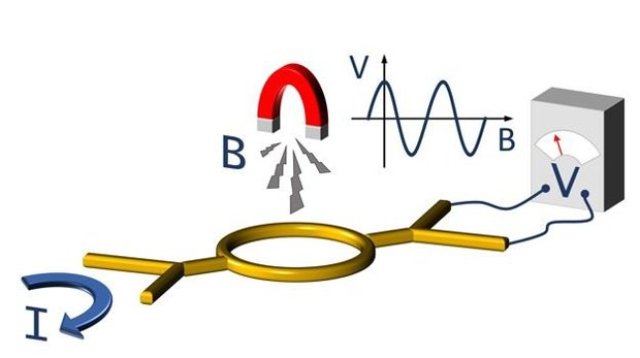 Schematic representation of the nonlocal electron interference experiment. A dc current is driven from the upper left to the lower left contact. A nonlocal, oscillating voltage is measured between the upper and lower right contacts due the magnetic-field induced single-electron interference in the 500 nanometer ring in the middle.
Schematic representation of the nonlocal electron interference experiment. A dc current is driven from the upper left to the lower left contact. A nonlocal, oscillating voltage is measured between the upper and lower right contacts due the magnetic-field induced single-electron interference in the 500 nanometer ring in the middle.
Researchers at the MESA+ research institute at the University of Twente have identified a new fundamental quantum mechanical property of electrical currents in nanoscale quantum circuits.
The team has demonstrated the way whereby electrons have the ability to spread out over the nanoscale circuits, similar to waves, and induce interference effects at specific places that are not driven by electrical current. This is considered to be the nonlocal effect, where the quantum circuit’s geometry plays an important role. The circuit’s specific geometry and the electrons’ quantum mechanical wave character are the reason for these interference effects. These effects must be considered when designing quantum computers.
Interference takes place when coherent interaction occurs between one or more propagating waves. It is a common, naturally occurring phenomenon in light, sound and water waves. However, electrons that carry electrical current can also interfere. Hence, in nanoscale circuits at very low temperatures, electrons must also be considered as waves. This phenomenon could be considered as quantum mechanical wave-particle duality.
Nanotechnologists at MESA+ successfully demonstrated electron interference in a 500nm gold ring. They connected one side of the ring to a miniature wire, which was used to drive an electric current. The other side of the ring was connected to a voltmeter through a wire. The researchers applied current and sent a varying magnetic field through the ring. Current did not flow through the ring; however, electron interference was detected at the ring’s other side.
The possibility of electron waves leaking into the ring and modifying electrical properties has been demonstrated through this study. Typically, this leakage or modification should not have occurred. Furthermore, the team observed that this effect was more pronounced even though the gold ring was diffusive.
The effect is due to the nonlocality of quantum equations of motion, which is also widely known as another nonlocality type – an object’s counterintuitive ability to know about the other’s state instantaneously. This is considered to be “spooky action at a distance,” as Einstein called it. The results of this study help better understand dynamical nonlocality, which is the first type of nonlocality. This nonlocality is considered to play a critical role in quantum interference experiments. Decoherence, where loss of phase memory occurs due to the physical environment, and “which-path-measurement,” which involves removal of dynamical nonlocality to destroy the interference pattern, thus affecting quantum interference.
Nanotechnologists at the University of Twente have found a method to affect the dynamical nonlocality, specifically the circuit’s geometry. This fundamental effect has to be well understood for quantum information processing and designing quantum computers.
The study paper, entitled “Geometric reduction of dynamical nonlocality in nanoscale quantum circuits,” has been published in the journal Scientific Reports.